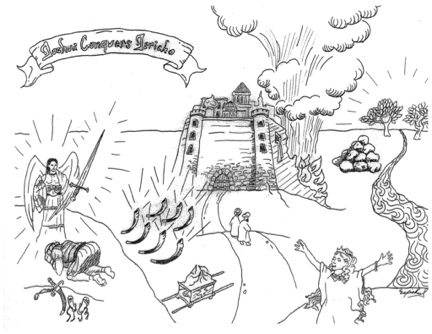Normal
0false
false
falseMicrosoftInternetExplorer4
st1:*{behavior:url(#ieooui) }
/* Style Definitions */
table.MsoNormalTable
{mso-style-name:”Table Normal”;
mso-tstyle-rowband-size:0;
mso-tstyle-colband-size:0;
mso-style-noshow:yes;
mso-style-parent:””;
mso-padding-alt:0in 5.4pt 0in 5.4pt;
mso-para-margin:0in;
mso-para-margin-bottom:.0001pt;
mso-pagination:widow-orphan;
font-size:10.0pt;
font-family:”Times New Roman”;
mso-ansi-language:#0400;
mso-fareast-language:#0400;
mso-bidi-language:#0400;}
By common agreement there is no book of the New Testament more challenging than Revelation. Interpretations in the commentary literature are more diverse, opinions respecting its use of the Old Testament are more divided, and the highly allusive and figurative character of the book itself is more disputed than any other received text from the first century.
Clearly no consensus has emerged among Revelation scholarship. The procedure of most scholars seems to be centered on trying to determine the context by which the book can make sense, both with respect to its genre and to its interpretive frame.
The Book of Joshua and its influence on Revelation has so far escaped the radar of modern scholarship, although it was widely recognized among the church fathers as a book prefiguring the end of the age. In particular, it is the account of Joshua’s battle against Jericho that attracted the attention of the fathers. They understood the profound significance of Joshua’s battle against Jericho as a prefiguration of Jesus’ battle against Jerusalem. They read the Septuagint account wherein the Greek text ascribes the battle to “Jesus” (Gk. Iesous). They understood the profound significance of the “Joshua” name of Jesus. They saw in Rahab a type of the church.
Finally, they understood Joshua’s battle against Jericho to foretell the battle of Jesus against Jerusalem.
While modern scholarship has looked predominantly to the latter prophets, Daniel, Ezekiel, and Isaiah especially, to find a prophetic context for the most challenging book of the New Testament, we raise the question whether the larger interpretive framework might actually be among the Old Testament history books, namely the Book of Joshua. The narrative drama of Revelation, that is its great theme, is that of the holy war Jesus wages against the Great City that is doomed to fall before him. Let’s begin by noting some of the most striking similarities that would have been noted by first century believers who saw in Jesus a new Joshua.
Joshua’s battle against Jericho, the great city, is significant because he must win his battle against this city before the people of God can receive their inheritance in the land of promise. The city is walled up against him. It is a city rich in gold and silver and merchandise (garments) from Shinar (i.e., Babylon, Josh 6:21). In the city lives a whore, whose scarlet marks her house. Joshua sends two spies into the city to bring him a witness report. A divine Warrior comes from heaven with a sword drawn for battle. Joshua falls at his feet and receives the battle order. The people purify themselves for a campaign that is to be a holy war marked by the sounding of seven trumpets followed by a shout. There are three series of sevens. The people march around the city each day for six days. On the seventh day, the people circle the city seven times. Then on the seventh circuit, the priests sound seven trumpets and the people shout. The great city falls down before them. The family of righteous Rahab is rescued before the city is put to the sword and burned.
The dramatic narrative of Revelation is strikingly similar. The entire book appears to be driven by this most fundamental retelling of Joshua’s battle against Jericho. The extent of shared vocabulary and the overlap of unique and specific language between the Septuagint account of Jericho and Revelation are certainly far more compelling than interpretive models taken from the later prophets. Although much exquisite allusion has been documented from other Old Testament books by modern critics in interpreting this profoundly rich New Testament portrait of Jesus in Revelation, what Old Testament book can compete with the vision of Joshua’s holy war waged upon the battlefield of Jericho? Where is the specificity that compares with the two texts interwoven by the scarlet of a whore, the great city appointed to fall before Joshua (Jesus), the two witnesses sent into the city, the appearance of the divine Commander with a sword come from heaven, the sounding of seven trumpets, and the rescue of the family of faith before the city is destroyed as the people of God receive their inheritance?
The narrative drama itself displays a complexity that moves beyond the realm of any judgment of randomness. To see this, let’s look at the following picture displaying the battlefield (what our German friends call a Kampfplatz) of Jericho.

Moving from right to left in the picture, we notice the Jordan River on the far right, the boundary that marks the entrance of the people of God into their inheritance. Joshua had commissioned the chieftains of the twelve tribes to build a mound of twelve stones taken from the river to memorialize their crossing. The place, Gilgal, is where Joshua circumcised the people and reinstituted Passover, and so by removing the uncleanness of the people made them competent to wage holy war. The image of a woman giving praise to God is Rahab, who has been rescued from her whoredom and the fiery judgment of her city. She wears a crown to show the full dimension of her redemption, for she will seek regular marriage and so become one of the mothers of the kings of Judah.
In the distance can be seen her window marked by her scarlet. The walls of the city have fallen down as judgment of sword and fire come upon the great city. The two spies are seen on the road leading into the city. Seven trumpets along with the Ark are shown, which portend the judgment of the city. There had been a series of three sevens: seven marches on seven days, seven marches on the seventh day, and seven trumpets on the seventh march. To the far left of the picture is the figure of the Commander come from heaven with a sword. Joshua has fallen upon his feet before the divine warrior.
We can now take this very battlefield and transform it into the dramatic stage of Revelation. Beginning from left to right, we recall that the Lord Jesus appears from heaven to John, who falls at his feet. The Lord comes with a sword proceeding from his mouth for he has come to wage holy war against the Great City. The Lord gives instructions to his churches to leave behind their uncleanness and to prepare themselves for holy war that they might receive their inheritance in the bridal city. The battle plan proceeds by three series of sevens: seven seals are opened and the seventh seal becomes seven trumpets, the seventh trumpet becomes seven vials of judgment.
The two witnesses recall the two spies against the city. The judgment begins when the great city falls after the seven trumpets sound Fiery judgment overtakes the city, but before it can be burned a voice comes from heaven calling forth “My people” from the wicked city. They, like Rahab, have been rescued from the city which is the mother of harlots. They have left their old life to become the espoused of the Lord. Their inheritance will become the New Jerusalem, built on the banks of the Crystal River. The city has twelve foundations of precious stones. The city and her gates recall the twelve tribes of Israel as well as the twelve apostles of Jesus.
This book is intended to restore the Book of Joshua to the place of prominence among gospel preachers and teachers that the book once enjoyed among the early church. It begins with an essay showing the significance of the Book of Joshua to the New Testament writers. Included in this essay is an expansive treatment of the interleaving of significant vocabulary, going well beyond the sketch of this introduction, between the books of Joshua and Revelation. Within the biblical world, history is prophecy. Therefore Joshua, as the first book listed among the prophets (the Nevi’im), should not be overlooked for its interpretive value in approaching Revelation.
The second part of this book is intended to help gospel expositors (preachers and teachers) in identifying the great redemptive themes of this most magnificent and in many ways perhaps the most typical book of Jesus in the Hebrew Bible.
The great gospel theme is announced in a dream vision to Joseph of Bethlehem when he is told, “you shall call his name ‘Joshua,’ (Gk. Iesous), for he will save his people from their sins” (Matt 1:21). It is the saving name of Joshua (Jesus), which is given to the One who rescues those like Rahab, caught in notorious sin, and yet who are the blessed ones who have been given precious and justifying faith and who therefore rescue others (Heb 11:31; Jas 2:25). This book is written for all the blessed ones, those who have been given the grace to see themselves in the same desperate need as was Rahab, the need to be delivered from sin and judgment, for all those who can hear in the trumpets not the blast of judgment but the sound of the coming of the One who brings rescue, all who long for the day when they will be with their Joshua forever among the great company of the people of faith. All our sins, like Rahab’s, were scarlet. But our Joshua has come and we have washed our garments in his blood and now we are dressed in garments of his righteousness, whiter than snow. Truly our Joshua has saved us from our sins!
[] See Jean Danielou, S.J., “The Fall of Jericho and the End of the World,” From Shadows to Reality: Studies in the Biblical Typology of the Fathers, (Eugene, OR: Wipf and Stock, originally published in 1960 by Continuum), pp. 276-286.
[] Danielou, pp. 229-243.
[] Danielou, pp. 244-261. The apostles themselves taught the church fathers. It is therefore striking to note that Rahab is given an outsized prominence in the New Testament as well. Rahab is mentioned in only two chapters in Joshua (2 and 6), but she is named in the royal genealogy of Jesus (Matt 1:5), hers, rather than the expected name of Joshua, is cited in the list of faith heroes in Hebrews (Heb 11:31), and she is given equal dignity with Abraham in the matter of faith by James (Jas 2:25). Clearly the focus on Rahab in the church fathers is anticipated already by the apostles in the New Testament.
[] Danielou, pp. 276-286.
[] See G. K. Beale, John’s Use of the Old Testament in Revelation (Sheffield, Eng.: Sheffield Academic Press, 1998), pp. 15-29.
[] We should keep in mind, however, that Joshua is the first book among the “prophets” in the Hebrew Bible.
[] We have pointed out the specificity of the overlapping language and the complexity of the dramatic narrative between the two books to suggest the clear intent of John to give us a portrait of Jesus as a new Joshua. The specificity and complexity exceed the possibility of mere randomness, it seems to us. A comparison would be to understand the difference between randomness and complex specificity as like that between New Hampshire’s Old Man of the Mountain, which is a natural rock formation analogous to a human face, and the figures carved into South Dakota’s Mount Rushmore. No one viewing the circle-rimmed spectacles of the figure of President Roosevelt could reasonably doubt that the image was deliberately carved into the mountain. By the same logic, it appears indisputable that the complex, dramatic narratives of Revelation along with the specific vocabulary constituting a striking interleaving require a recognition of Revelation’s large dependence upon Joshua.
[] The essay on the typology of Joshua has been previously published by St Andrews House and Logos Bible Software in the book entitled Biblical Theological Essays.
